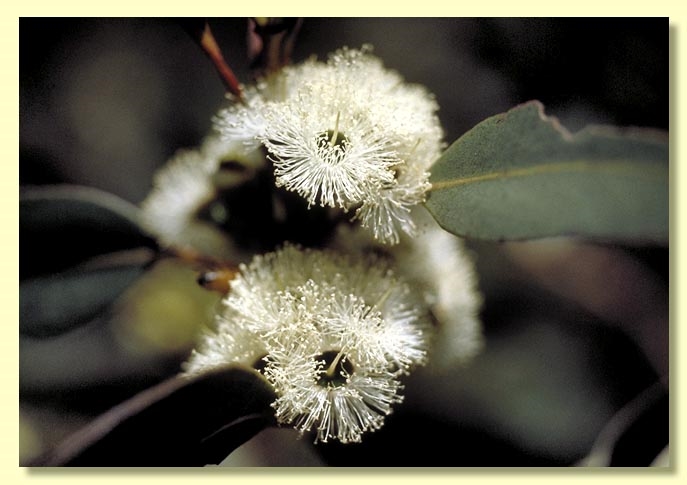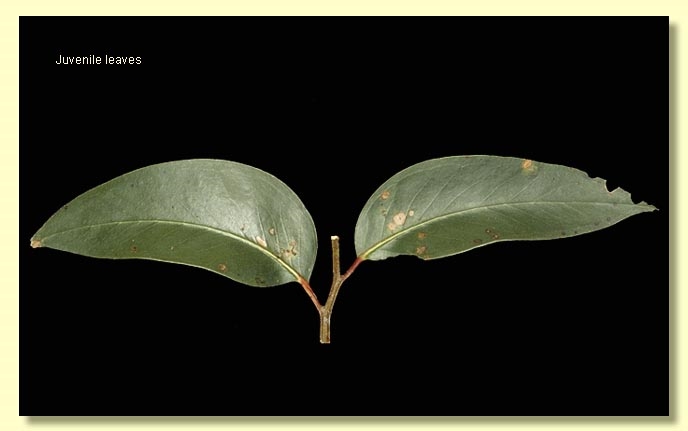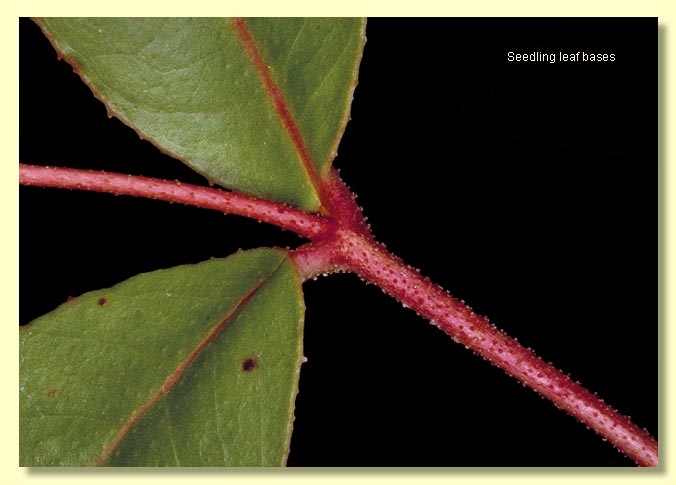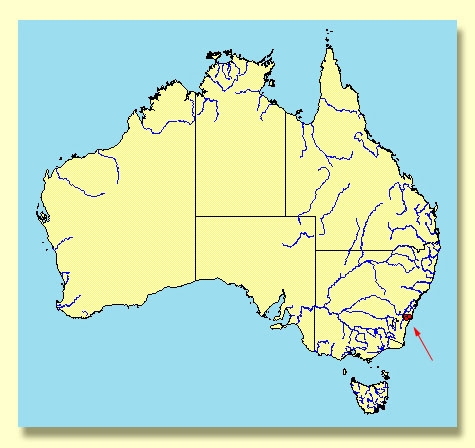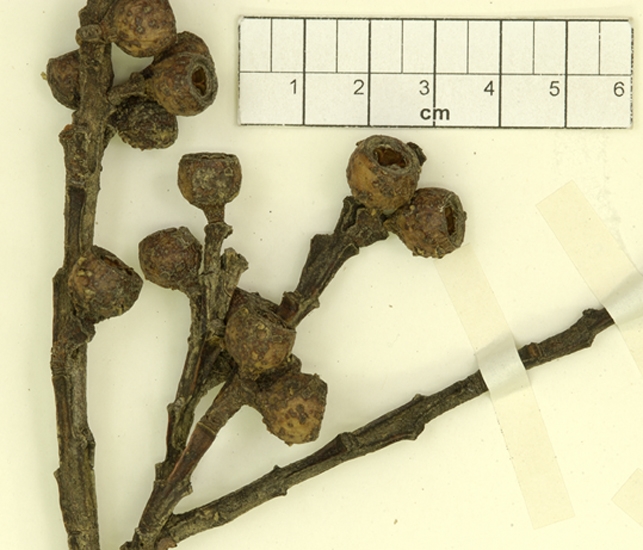Euclid - Online edition
Eucalyptus langleyi
Classification
Eucalyptus | Eucalyptus | Eucalyptus | Strictae | Irregulares
Nomenclature
Description
Mallee to 5 m tall. Forming a lignotuber.
Bark smooth throughout or with a few persistent strips at base of stems; smooth bark shedding in ribbons, grey, pinkish grey and yellow to brown.
Juvenile growth (coppice or field seedlings to 50 cm): stem square in cross section and often prominently winged, densely warty on lower stems; juvenile leaves opposite, sessile to subsessile and elliptic for ca 4 nodes then alternate, petiolate, lanceolate to falcate, 9–14 cm long, 2–5.5 cm wide, glossy, green.
Adult leaves alternate, petiole 1–2.3 cm long; blade broadly falcate to lanceolate, 8–16.5 cm long, 1.8–5 cm wide, base oblique or tapering to petiole, concolorous, glossy, green, side-veins acute, reticulation invisible, intramarginal vein well removed from margin, oil glands very irregular, island.
Inflorescence axillary unbranched, peduncles 0.6–1.2 cm long, buds 7 per umbel, pedicels 0.1–0.4 cm long. Mature buds obovoid to oblong, 0.7–0.9 cm long, 0.4–0.5 cm wide, green to yellow, smooth or warty, angled longitudinally, scar absent, operculum conical to rounded to beaked, stamens irregularly flexed, anthers reniform to cordate, versatile, dorsifixed, dehiscing by confluent slits, style long, stigma tapered, locules 3 or 4, the placentae each with 2 vertical ovule rows. Flowers white.
Fruit pedicellate (pedicels 0.1–0.4 cm long), cup-shaped or barrel-shaped, 0.7–1 cm long, 0.8–1.2 cm wide, disc descending, valves 3 or 4, near rim level or enclosed.
Seeds dark brown, 1.5–3 mm long, pyramidal or obliquely pyramidal, dorsal surface smooth, hilum terminal.
Cultivated seedlings (measured at ca node 10): cotyledons reniform; stems rounded to square in cross-section, scabrid on lower part; leaves sessile to subsessile, opposite for 4 pairs then alternate, ovate-lanceolate, 10–17 cm long, 3–5.5 cm wide, base truncate to rounded then tapering, margin entire, apex pointed, concolorous, glossy, green, thick. Lowest leaves scabrid on petiole and midrib underneath.
Bark smooth throughout or with a few persistent strips at base of stems; smooth bark shedding in ribbons, grey, pinkish grey and yellow to brown.
Juvenile growth (coppice or field seedlings to 50 cm): stem square in cross section and often prominently winged, densely warty on lower stems; juvenile leaves opposite, sessile to subsessile and elliptic for ca 4 nodes then alternate, petiolate, lanceolate to falcate, 9–14 cm long, 2–5.5 cm wide, glossy, green.
Adult leaves alternate, petiole 1–2.3 cm long; blade broadly falcate to lanceolate, 8–16.5 cm long, 1.8–5 cm wide, base oblique or tapering to petiole, concolorous, glossy, green, side-veins acute, reticulation invisible, intramarginal vein well removed from margin, oil glands very irregular, island.
Inflorescence axillary unbranched, peduncles 0.6–1.2 cm long, buds 7 per umbel, pedicels 0.1–0.4 cm long. Mature buds obovoid to oblong, 0.7–0.9 cm long, 0.4–0.5 cm wide, green to yellow, smooth or warty, angled longitudinally, scar absent, operculum conical to rounded to beaked, stamens irregularly flexed, anthers reniform to cordate, versatile, dorsifixed, dehiscing by confluent slits, style long, stigma tapered, locules 3 or 4, the placentae each with 2 vertical ovule rows. Flowers white.
Fruit pedicellate (pedicels 0.1–0.4 cm long), cup-shaped or barrel-shaped, 0.7–1 cm long, 0.8–1.2 cm wide, disc descending, valves 3 or 4, near rim level or enclosed.
Seeds dark brown, 1.5–3 mm long, pyramidal or obliquely pyramidal, dorsal surface smooth, hilum terminal.
Cultivated seedlings (measured at ca node 10): cotyledons reniform; stems rounded to square in cross-section, scabrid on lower part; leaves sessile to subsessile, opposite for 4 pairs then alternate, ovate-lanceolate, 10–17 cm long, 3–5.5 cm wide, base truncate to rounded then tapering, margin entire, apex pointed, concolorous, glossy, green, thick. Lowest leaves scabrid on petiole and midrib underneath.
Flowering Time
Flowering has been recorded in May, September and November.
Notes
Eucalyptus langleyi is a mallee ash endemic to New South Wales, of very restricted distribution on the subcoastal plain south-west of Nowra where it is known from only two stands. It has smooth bark and glossy green adult leaves.
Eucalyptus langleyi belongs to the green-leaved mallee ash group of species, and is a taxon at the robust end of a series from the linear-leaved E. apiculata through E. stricta and to the broader, lanceolate-leaved E. burgessiana. It differs from these three species by the larger leaves, buds and fruits and, particularly, the angled branchlets. It somewhat resembles E. luehmanniana from south and north of Sydney, which differs in being a blue-leaved ash with coarser leaves, and yellow or glaucous buds and fruits.
Eucalyptus langleyi belongs in Eucalyptus subgenus Eucalyptus section Eucalyptus series Strictae, because of a combination of characters: mallee habit with smooth bark, alternate, green juvenile leaves, adult leaves with acute side-veins and little or no visible reticulation, single axillary inflorescences, the buds in clusters of sevens, with buds having only one operculum and reniform anthers, ovules in two rows, and more or less pyramidal seeds. Within series Strictae, E. langleyi is one of six closely related species all with leaf oil glands that are irregular in outline (subseries Irregulares), the others being: E. dendromorpha (a partly rough-barked tree with clavate buds in sevens); E. triflora (a small more or less smooth-barked tree with oblong buds in threes or sevens); and E. apiculata, E. stricta and E. burgessiana, which differ as described above.
Eucalyptus langleyi is listed as "Vulnerable" under the Australian Government Environment Protection and Biodiversity Conservation Act 1999 (EPBC Act). Further information may be found at this web address:
http://www.environment.gov.au/cgi-bin/sprat/public/sprat.pl
Eucalyptus langleyi belongs to the green-leaved mallee ash group of species, and is a taxon at the robust end of a series from the linear-leaved E. apiculata through E. stricta and to the broader, lanceolate-leaved E. burgessiana. It differs from these three species by the larger leaves, buds and fruits and, particularly, the angled branchlets. It somewhat resembles E. luehmanniana from south and north of Sydney, which differs in being a blue-leaved ash with coarser leaves, and yellow or glaucous buds and fruits.
Eucalyptus langleyi belongs in Eucalyptus subgenus Eucalyptus section Eucalyptus series Strictae, because of a combination of characters: mallee habit with smooth bark, alternate, green juvenile leaves, adult leaves with acute side-veins and little or no visible reticulation, single axillary inflorescences, the buds in clusters of sevens, with buds having only one operculum and reniform anthers, ovules in two rows, and more or less pyramidal seeds. Within series Strictae, E. langleyi is one of six closely related species all with leaf oil glands that are irregular in outline (subseries Irregulares), the others being: E. dendromorpha (a partly rough-barked tree with clavate buds in sevens); E. triflora (a small more or less smooth-barked tree with oblong buds in threes or sevens); and E. apiculata, E. stricta and E. burgessiana, which differ as described above.
Eucalyptus langleyi is listed as "Vulnerable" under the Australian Government Environment Protection and Biodiversity Conservation Act 1999 (EPBC Act). Further information may be found at this web address:
http://www.environment.gov.au/cgi-bin/sprat/public/sprat.pl
Origin of Name
Eucalyptus langleyi: after Laurence Joseph Langley (1917-2007). In the late 1950s Laurence Langley joined the Forestry and Timber Bureau in Canberra. He resigned his position in 1957 and moved to Robertson, New South Wales to be an independent supplier of seeds, especially those of eucalypts. He was the foundation member of the Australian Plant Society and founded the Australian Seed Company. It was Langley who first discovered the plant which is now named in his honour.
Copyright © CANBR 2020, all rights reserved.

Web edition hosted at https://apps.lucidcentral.org/euclid





